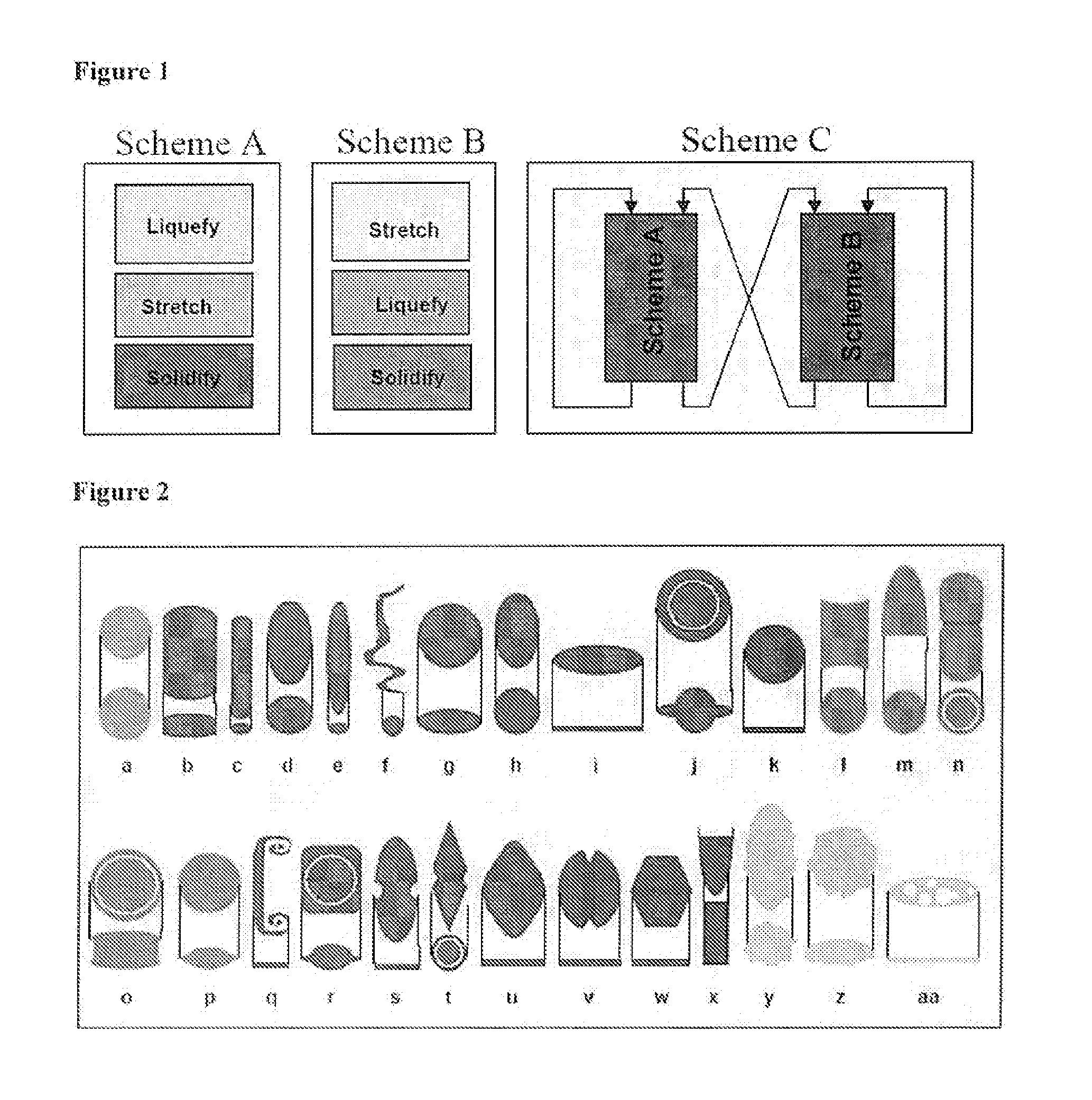Engineering shape of polymeric micro- and nanoparticles
a nanoparticle and polymer technology, applied in the direction of nanoparticles, microcapsules, capsule delivery, etc., can solve the problems of phagocytosis by professional phagocytes and components of the reticuloendothelial system, impede tissue-specific targeting, and limit the half-life of micro- and nanoparticle circulation
- Summary
- Abstract
- Description
- Claims
- Application Information
AI Technical Summary
Benefits of technology
Problems solved by technology
Method used
Image
Examples
example 1
Particles Produced Using Scheme A
[0109]The fabrication conditions used to generate the particles discussed in this example are shown schematically in FIG. 1, Scheme A, and in Table 1.
TABLE 1Fabrication conditions for particles reported in Example 1OriginalStretchingFilmSphereAspectThicknessParticleDiameterLiquefactionRatio of(μm),Name(μm)MethodfilmPlasticizer(b)5.7120° C.235, glycerolrectangulardisks(c)0.9120° C.10.935, glycerolrectangulardisks(d) rods0.9120° C.2.470, none(e) rods0.9120° C.5.570, none(f) worms0.9155° C.8.735, glycerol(g) oblate2.9125° C. 2 (2D)35, glycerolellipses(h) prolate0.9toluene1.135, glycerolellipses(i) elliptical1.8toluene4.935, glyceroldisks(j) UFOs5.7toluene2.3 (2D)35, glycerol(k) circular2.9toluene1.9 (2D)35, glyceroldisks
[0110]Results:
[0111]Simple stretching of particles in one dimension (1-D) led to the formation of several different shapes depending on the film properties and method of liquefaction. 1-D stretching of a 35 μm thick plasticized film at ...
example 2
Particles Produced Using Scheme B
[0113]The fabrication conditions used to generate the particles discussed in this example are shown schematically in FIG. 1, Scheme B, and in Table 2.
TABLE 2Fabrication conditions for particles reported in Example 2OriginalStretchingFilmSphereAspectThicknessParticleDiameterLiquefactionRatio of(μm),Name(μm)MethodfilmPlasticizer(a) barrels2.9130° C.1.635, none(b) bullets2.9140° C.1.635, none(c) pills2.9toluene3, film35, glyceroldried offstretcher(d) pulleys9toluene1.8 (2D)35, glycerol(e) bi-convex0.9toluene1.8 (2D)35, glycerollenses
[0114]Results
[0115]1-D stretching of the film without particle-liquefaction creates an ellipsoidal void around the particle. Upon heat-induced liquefaction, polystyrene fills the void in a temperature-dependent manner. At relatively low temperatures (130° C.), the particle remains in the middle of the void and results in a barrel-like structure upon solidification with concave regions at both ends. Interestingly, liquefactio...
example 3
Particles Produced Using Scheme C
[0117]The fabrication conditions used to generate the particles discussed in this example are shown in Table 3.
TABLE 3Fabrication conditions for particles reported in Example 3OriginalStretchingFilmSphereAspectThicknessParticleDiameterRatio of(μm),Name(μm)ProcedurefilmPlasticizer(a) ribbons2.9Stretch in air, liquify4, 435,with toluene, dry inglycerolair, reinforce withPVA, stretch in air,liquefy with toluene(b) bicones0.9Start with elliptical3, 335,disks, reinforce withglycerolPVA, liquefy withtoluene, stretch(c)2.9Start with elliptical3, 235,diamonddisks, reinforce withglyceroldisksPVA, liquefy with,stretch along theminor axis oforiginal ellipticaldisks(d)2.9Stretch in air,3, 235,emarginateliquefy with toluene,glyceroldisksdry in air andisopropanol,reinforce with PVA,stretch in air perp.,liquify with toluene(e) flat pills2.9Stretch sequentially1.5, 1.5,35,along both diagonals3, 4glycerolin air, stretch alongthe length, liquefy at120° C., cool to roo...
PUM
 Login to View More
Login to View More Abstract
Description
Claims
Application Information
 Login to View More
Login to View More - R&D
- Intellectual Property
- Life Sciences
- Materials
- Tech Scout
- Unparalleled Data Quality
- Higher Quality Content
- 60% Fewer Hallucinations
Browse by: Latest US Patents, China's latest patents, Technical Efficacy Thesaurus, Application Domain, Technology Topic, Popular Technical Reports.
© 2025 PatSnap. All rights reserved.Legal|Privacy policy|Modern Slavery Act Transparency Statement|Sitemap|About US| Contact US: help@patsnap.com



